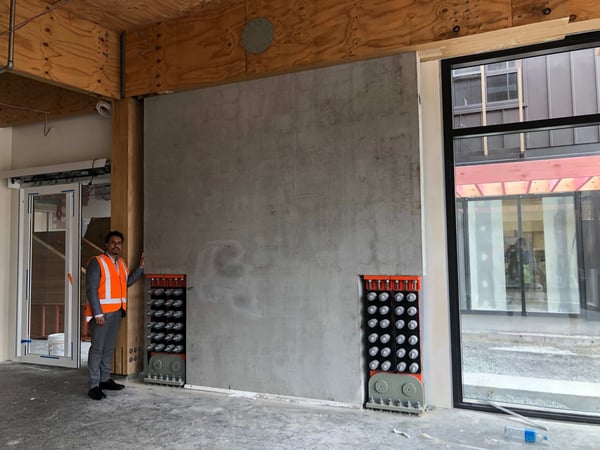In high seismic regions, earthquakes pose a significant threat to the safety and resilience of buildings and infrastructure. Structural engineers play a central role in developing innovative solutions to minimize the impact of seismic events on people, buildings and communities.
One such approach is the concept of 'Low Damage Design' which focuses on reducing the structural damage caused by earthquakes. This article explores the principles, strategies, and advanced techniques employed in Low Damage Design to enhance seismic performance for buildings in high-risk areas.
Understanding Seismic Hazards
Seismic hazards are quantified using parameters like peak ground acceleration (PGA) and spectral acceleration (SA). In high seismic regions, buildings are often subjected to strong ground shaking, which can lead to structural damage, endanger human lives, and disrupt vital services. A crucial goal for structural engineers is to design buildings that can withstand these forces and remain operational after an earthquake.
Low Damage Design Principles
The principles of Low Damage Design are rooted in the concept of "damage control." Rather than creating structures that remain completely undamaged during an earthquake, the focus is on developing buildings that can absorb and dissipate seismic energy while sustaining minimal, repairable damage. Engineers achieve this by localizing the damage to known locations, making it easier to go back and make repairs or replacements should an earthquake occur.
Key principles of Low Damage Design include:
- Ductility: Ductility is the ability of a structure to deform plastically without failing. Materials like reinforced concrete and steel exhibit ductile behavior, which allows them to undergo substantial deformation while maintaining their integrity. This helps in absorbing seismic energy and mitigating damage.
- Energy Dissipation: Low damage design incorporates energy dissipation devices, such as yielding steel components, dampers and isolators, into the building's structural system. These devices absorb and dissipate seismic energy, reducing the forces transmitted to the main building elements.
- Redundancy: Building systems with redundant load paths provide alternative routes for load transfer during an earthquake. This redundancy ensures that even if some elements are damaged, the building can still resist seismic forces.
 Tectonus self-centering friction dampers are used to create buildings that sustain low damage in an earthquake .
Tectonus self-centering friction dampers are used to create buildings that sustain low damage in an earthquake .
Technology in Low Damage Design
Several advanced technologies have been developed to enhance the effectiveness of Low Damage Design:
- Base Isolation: Base isolation involves placing flexible bearings between the building's foundation and superstructure. These bearings allow the building to move independently of the ground motion during an earthquake, effectively isolating it from damaging forces.
- Seismic Dampers : Devices like friction dampers, viscous dampers and tuned mass dampers are installed in buildings to absorb and dissipate seismic energy. Friction dampers dissipate energy through friction. Viscous dampers use fluid mechanics to dissipate energy, while tuned mass dampers mitigate vibrations by oscillating out of phase with the building's natural frequency.
- Design Techniques: Design tools like advanced computational modeling and non-linear time history analysis allow engineers to explore and analyze the impact of different design decisions on the performance of the structure. Non-linear time history subjects a computational model of the building structure to a series of historical earthquakes and outputs parameters such as displacement, base shear, and residual drift.
Success Stories in Low Damage Design
Several notable buildings designed with Low Damage Design principles have demonstrated outstanding seismic performance:
- Taipei 101, Taiwan: One of the tallest skyscrapers globally, Taipei 101 employs a tuned mass damper to counteract swaying caused by earthquakes and typhoons. This innovative feature significantly enhances its seismic resilience.
- The San Francisco Federal Building, USA: This building utilizes buckling-restrained braces, which are energy-dissipating devices that enable it to withstand strong seismic forces while maintaining structural integrity.
- Nelson Airport, New Zealand. This building utilizes the latest damping technology from Tectonus which allows the structure to automatically re-centre itself after the shaking stops. Limiting residual drift reduces damage and downtime post-earthquake.
 Nelson Airport, New Zealand, was designed by engineers Dunning Thornton using Low Damage Design principles.
Nelson Airport, New Zealand, was designed by engineers Dunning Thornton using Low Damage Design principles.
The Way Forward
Low Damage Design represents a groundbreaking approach to mitigating seismic risks for buildings in high seismic regions. Going beyond simply ensuring life safety, structural engineers are using the concept to design buildings that are more likely to survive an earthquake, cost less to repair, and that allow the occupiers to get back up and running quickly. By adopting principles of ductility, energy dissipation, and redundancy, and implementing advanced techniques such as base isolation and seismic dampers, these engineers are revolutionizing earthquake-resistant design.
Further reading
Recommended further readings on the topic of Low Damage Design:
- "Seismic Design of Buildings to Eurocode 8" by Ahmad Y. Elghazouli - This book provides comprehensive guidance on seismic design principles according to Eurocode 8, a European standard for seismic design. It covers various design concepts, including low damage design, and offers practical examples for structural engineers.
- "Seismic Design of Reinforced Concrete and Masonry Buildings" by Thomas Paulay and M.J.N. Priestley - This classic reference book presents in-depth insights into the seismic design of reinforced concrete and masonry structures. It includes discussions on ductility-based design principles and concepts relevant to low damage design.
- "Design of Low-Damage Buildings" by A.S. Elnashai and L. Di Sarno - This book explores the principles of low damage design and presents a methodology for designing earthquake-resistant structures with damage-limiting capabilities. It discusses various advanced techniques used in low damage design.
- "Performance-Based Seismic Design Concepts and Implementation" by Michael R. Willford and Ronald Hamburger - This technical publication focuses on performance-based design principles, which are central to low damage design. It delves into the integration of performance objectives with seismic design and assessment methodologies.
- "Design of Seismic Isolated Structures: From Theory to Practice" by Farzad Naeim - This book provides a comprehensive guide to the design and implementation of base isolation systems, a critical aspect of low damage design. It covers various types of isolators and their applications in seismic-resistant buildings.
- "Seismic Resistant Steel Structures" by Michael R. Lindeburg - This book emphasizes the use of steel structures for earthquake resistance. It covers design strategies to enhance the seismic performance of steel buildings, including low damage design concepts.
- "Performance-Based Seismic Engineering: Vision for an Earthquake Resilient Society" - This article by Gregory G. Deierlein and Helmut Krawinkler discusses the importance of performance-based seismic engineering in enhancing the resilience of buildings. It highlights the role of low damage design in achieving these performance objectives.
- "Innovations for Seismic Design and Retrofit of Buildings" - This report by the National Academies Press examines the latest innovations in seismic design and retrofitting practices for buildings. It includes discussions on low damage design and its significance in mitigating earthquake risks.
Please note that some of these resources may require purchase or institutional access. Additionally, academic journals and technical conference proceedings in the field of earthquake engineering can also be excellent sources for further research and exploration.
